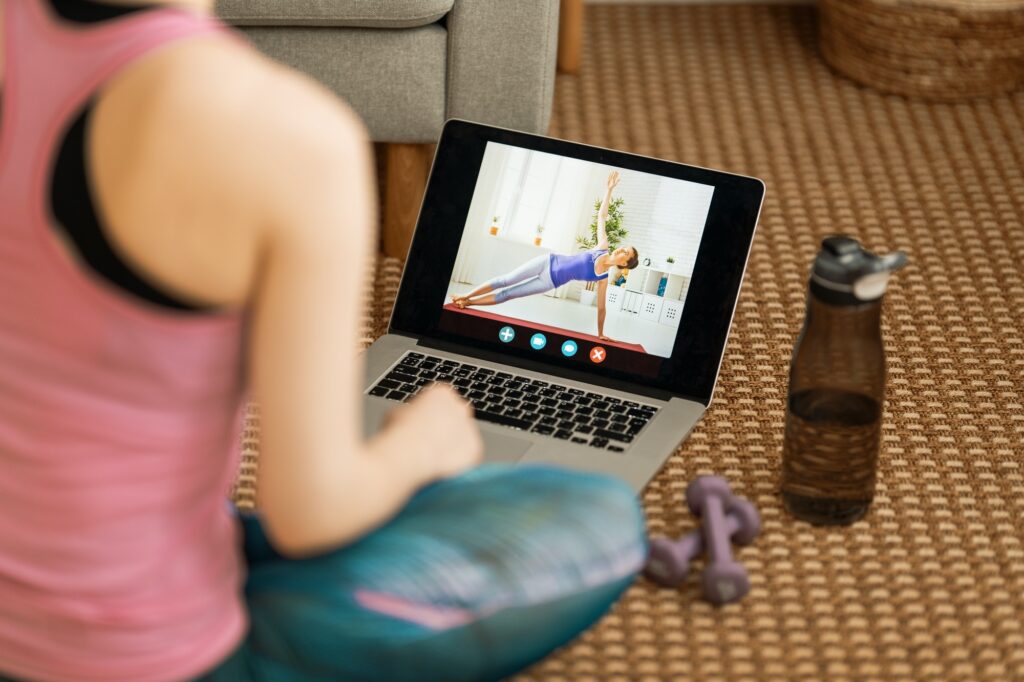Working from home has become increasingly common over the past few years. While there are many benefits, like flexibility and no commute, it also comes with challenges. When your home is your office, it can be difficult to balance work and wellness. Without a conscious effort to prioritize health and well-being, burnout is a real risk.
The good news is there are many things you can do to create a better balance working from home. With some simple strategies around your schedule, workspace, social connections, diet, exercise, and self-care, you can thrive in your remote work arrangement. This article outlines tips to blend productivity with wellness.

Balancing Work and Wellness
Create Structure in Your Day
When you don’t have to show up to a workplace at set times, it’s easy for work to bleed into all hours. Without boundaries, you may end up overworking or have trouble focusing. That’s why creating structure is so important when working from home.
Dedicate standard work hours for yourself and try to stick to them. Define a consistent start and end time for your workday, just as if you were going into an office. You can be flexible if needed, but keeping regular hours helps signal to your brain when it’s time to focus and when it’s time to disconnect.
Building in small breaks throughout the day is also key. Get up and move around for a few minutes every hour. Take a longer break at lunch to eat, stretch, or get outside. Consider dividing your work hours into chunks of focused work time, with regular 10-15 minute breaks in between. The Pomodoro technique uses a timer for 25-minute work sprints.
Without commute time, you may gain back 2+ hours a day working remotely. Decide intentionally how to invest this extra time rather than letting work continually expand. Use it to get more rest, exercise, connect with loved ones or engage in hobbies.
Optimize Your Workspace
When you don’t leave the house all day, it’s important for both productivity and mental health to have a designated workspace. Ideally, set up a comfortable, dedicated office area if possible, not just working from your couch or bed. This space should be quiet, free from distractions, and only used for work.
Make sure your workspace has everything you need – a supportive chair and adjustable sit/stand desk if possible, proper lighting, access to outlets, fast internet connection. Reduce physical strain by using ergonomic keyboards and mice.
Keep it organized so you can focus. Some people like music or background noise when working, while others prefer silence. Figure out what environment helps you get in flow. Upgrade your space as needed so it’s a pleasure rather than uncomfortably tolerable. Treat your home workspace with the same care you would an office one.

Stay Connected
One of the biggest downsides of remote work is lack of social interaction. Humans are wired to connect, so limited in-person time can negatively impact mental health. Feelings of isolation are common working from home if you live alone.
That’s why consciously focusing on relationships is vital. Use extra time not commuting to socialize virtually or safely in person when possible. Video chat frequently with coworkers to collaborate and catch up. Schedule virtual coffee dates with friends. Join groups related to hobbies or causes you care about. While digital interaction differs from face-to-face, maintaining bonds should still be a priority.
If you live with family, also be intentional about quality time together. Without commutes enabling regular connection, you have to integrate this. Share meals without distractions. Dedicate part of evenings or weekends for interaction. Go outside together when possible for fresh air and exercise. Splitting living and working spaces makes boundaries easier. Discuss needs and compromises openly with those you live with.

Adopt Healthy Eating Habits
Another challenge working remotely is snacking all day. The kitchen is just steps away, making poor food choices tempting. But nourishing your body properly helps sustain energy and focus required for peak performance. It also aids overall well-being.
Try to stick to regular meal schedules, just as if you were going into an office. Prep healthy snacks like fruits, vegetables and nuts to have on hand. Stay hydrated by drinking plenty of water throughout the day. Consider intermittent fasting schedules where you concentrate daily food intake into set windows.
When you aren’t using a lunch break to commute, take time to make yourself proper meals. Eat at a table without multitasking to be more mindful. Meal prepping a few days in advance saves effort and sets you up for better choices.
Be careful about alcohol consumption while working at home too. It may seem harmless to have a glass of wine or beer with lunch. But drinking frequently can impact productivity and health. Save it for strictly non-work hours instead.

Prioritize Exercise Daily
When you’re not walking to transit or between meetings, it’s vital to integrate intentional movement into work-from-home days. Regular exercise is as important for mental sharpness as physical health. Fortunately, you gain back commuting time perfect for fitting in fitness.
Try starting mornings with exercise to boost focus for work. Schedule time for a daily walk, jog, bike ride, YouTube workout video, etc. This encourages you to actually take a full lunch break instead of rushing through meals too.
Look for opportunities to make your remote workday more active in small ways as well – take walking meetings or calls, stand while collaborating on documents, and learn stretches to do between tasks. Set smartwatch or phone reminders to get up often.
Don’t let remote work become an entirely sedentary arrangement. Make physical activity a non-negotiable component of daily routines. Protect time for sufficient movement. Your mind, body, and work output will benefit.

Practice Regular Self-care
Working where you live blurs boundaries between personal and professional realms. Without a conscious effort to prioritize well-being, burnout is likely. That’s why integrating regular self-care practices is so necessary when working remotely.
Carve out time every single day for activities unrelated to work – reading, listening to music, gardening, journaling, meditation, etc. Continue investing in your hobbies. Strictly limit checking emails or messages during non-work hours.
Build in longer periods for self-care as well, like weekends off and scheduled PTO. Disconnect fully from work during these. Allow sufficient time completely away not thinking about workplace demands to recharge. The flexibility remote work provides means you can design tailored breaks around things most nourishing for you too.
Listen closely to your body and mind’s signals. Stress manifests physically and emotionally when you don’t take care of yourself. Monitor energy levels as well as mood fluctuations as barometers. If you start feeling continually exhausted, on edge or overwhelmed, make self-care even more of a priority. Working remotely removes natural triggers forcing you to rest. Be proactive about integrating practices serving your overall well-being rather than waiting until you desperately need intervention.
Many companies now actively encourage employees to practice self-care, even building it into official policies and programs. Take full advantage of any resources available and communicate additional needs as well. Everyone must find unique recipes supporting health, boundary setting, and resilience, minimizing burnout risk. Don’t hesitate to ask for support or adjustments enabling you to show up as your best self.

Set Tech Boundaries
Technology simultaneously enables working remotely while posing some of the biggest wellness challenges. When you utilize the same devices for professional and personal endeavors without limits, days never really end.
That’s why setting deliberate boundaries around technology is critical for disconnected time protecting your health. Define off-hour periods where you don’t engage in work communication and stick to them. Configure devices so you don’t receive notifications outside dedicated work time. Let calls go to voicemail and delay responding to messages if possible.
Build tech-free rituals into evenings, weekends and breaks too. For example, put phones away during family dinners or don’t bring your laptop into the bedroom. Consider tools like website blockers preventing access to distracting sites during work sprints as well. The fewer pings, alerts and temptations from devices, the easier it is to focus on non-work priorities.
Working remotely provides wonderful flexibility. But without a conscious effort to maintain balance, days never really end. This blurred separation between personal and professional realms poses a burnout risk over time. Luckily, there are many strategies that allow you to sustain productivity while safeguarding health while working from home.
Approach remote work arrangements holistically, considering nutrition, ergonomics, social connections, routine and self-care just as much as output. Don’t hesitate to communicate needs enabling you to show up at your best. With the right boundaries and support, you can thrive working remotely long term.
The tips outlined here provide a template for customizing your work-from-home lifestyle and optimizing success. Experiment to discover the unique recipe that helps you blend productivity with well-being in sustainable ways. Prioritize health as much as work output utilizing flexibility to your advantage. A balanced approach helps remote working arrangements benefit both employee and employer.
Frequently Asked Questions About Remote Work Wellness
Balancing work and wellness from home comes with unique benefits and challenges. Here are answers to some common questions about maintaining health in remote arrangements:
How much should I work per day when working remotely?
A common benchmark used by remote workers is roughly 8 hours per day. But the exact hours depend on your particular job and life demands. The key is setting clear boundaries so work does not continually infringe on personal time.
What is the easiest way to exercise working from home?
Schedule time for daily movement, just like any other important meeting. Short walks, jogs or bike rides are easy remote worker exercises. Simple home workouts require minimal equipment too. Leverage fitness apps and streaming services as well.
How often should I communicate with coworkers remotely?
Frequent communication is key to combating remote worker isolation. Ideally, have some form of social interaction multiple times per day via chat, video conferencing, etc. Update colleagues proactively on projects and seek feedback often. Overcommunication tends to work better than the alternative.
What are signs of burnout working from home I should watch for?
Exhaustion, cynicism about work, declining performance, lack of concentration, changes in sleep, appetite or mood, and loss of joy from professional and personal activities are all potential burnout signs. Listen closely to your body and mind’s signals.
How should I set up my home office?
Dedicate a quiet, distraction-free area solely for remote work whenever possible. Make sure it has strong WiFi, ample power outlets and lighting. Utilize ergonomic equipment promoting healthy posture and movement as well.
Can my employer help support wellness needs working remotely?
Many organizations now actively support remote worker health/wellness through policies, benefits or programs addressing unique challenges. Communicate openly about specific help that could enable you to thrive. Most want employees to succeed.
Balancing productivity with wellbeing and connection takes deliberate intention when office and home converge. But with some conscious planning, you can absolutely cultivate satisfying and sustainable work-from-home routines reducing burnout risk. Test different strategies and communicate needs to discover the approach optimizing your health and success.









